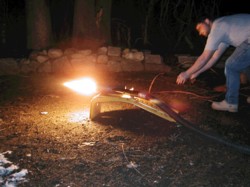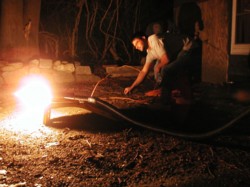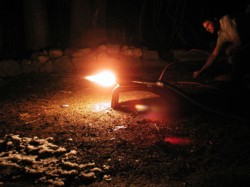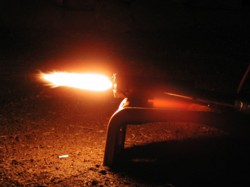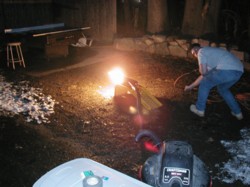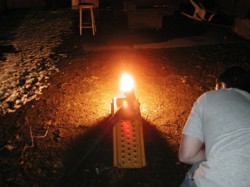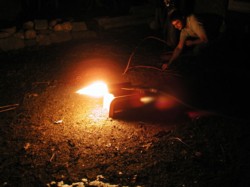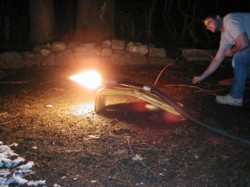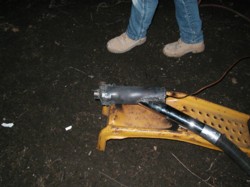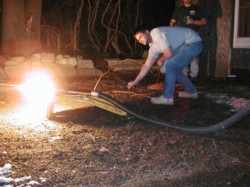 The
The JET POWERED CANOE
Project
 The
The
JET POWERED CANOE
Project
| What? | How? | Why? | Where are you now? |
What is the JET POWERED CANOE PROJECT you ask. Simple, make a turbo-jet engine in the garage and attatch it to a canoe. Why? Why not? You may have seen other sites out there on the subject of turbo jet engines. It's not a new concept. Making one is really quite simple.

You have an outer solid tube and an inner porous tube that share the same base. The base has a hole in it with a fuel jet screwed in. Ours in from a turkey fryer. The number of holes in the inner tube, or flame tube, and the amout of fuel flowing in (propane, acetylene, etc) set the air/feul mixture. This is critical to create a "self-sustaining" burn. If these factor are incorrect it will flame out, or not light at all. We found experimentation is the best way to find the right mix. Get a good fuel valve, start with few holes in the flame tube and add holes as you go. When the engine runs it is a really incredible sound! It's called a "turbo" jet engine because a car turbo is used to compress the out-going air and force it back into the engine for combustion.
So how do you power a canoe or anything else? Well, um, there are a couple of ways to extract power from a engine such as this. One is to put a second turbo fed from waste air and use it's shaft to drive something like a canoe for example. Another way would be to add a pully to the turbo that's already there to drive something for example a canoe. A much less effecient, but certainly more spectacular thing to do is just run the engine lean and let a two foot flame shoot out the back of the boat. Really not pushing you at all but a hell of a lot more impressive, don't you think?
Why attatch a jet engine to a canoe. Why not? Picture this, your canoeing down the Saco river in Maine. The sun is shining, the birds are singing. You ask you buddy to pass you a beer out of the cooler. He tosses it to you and you crack it open. Just as your about to take a sip you hear a rumbling. Looking around confused you turn to your buddy for an explanation. He shrugs. Suddenly a plastic Coleman RamX 300 doing at least 12 MPH comes screaming around the bend skipping over the water like a hydroplane. The guy in the front is wearing aviator goggles and a beer hat and the guy in the back is roasting hotdogs over a two foot long yellow flame with three mach diamonds in it. As they pass by you hear them yell "Want a hotdog?"
I know what your thinking, "what the hell is a mach diamond?" Right? Mach diamonds (or shock diamonds) are explained here at Georgia Tech. And here is a link to some cool movies of jet engines at xcor.com (with mach diamonds in the exhaust).
UPDATES:
I know your all wondering how long before we finish this thing. Well here is some history and updates (and some pictures too).
Early Stages
The early version of the engine used gas pipe. It took quite a lot of experimenting to get a self sustaining flame. Here are some pics of the original engine attached to the turbo charger. This turbo is from a 12 liter crane engine. The actual jet engine is the part between the white pipe and the turbo charger.
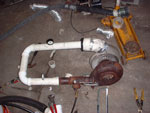
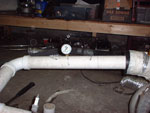
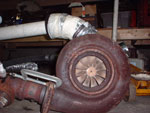
This engine was drastically underpowered for the turbo we had so we set out to build a bigger one. The next one we built from 16 guage sheet steel. We bent it into concentric cylinders and drilled the inner one. Then we welded an old harley muffler in the side as an air intake. We use a shop vac to start and test the engine. The vac provides the air to test the burnrate and air/fuel mixture. Here is a picture of the new engine:
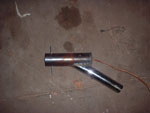
This engine self-sustained the first try! It seemed to be running very well with propane. So we hooked up the acetylene tank. This turned out to be a bad idea. At first it was burning very well.About a foot of yellow flame (a little too rich) then some chunks of red hot metal. Then a shower of red hot metal. We shut it down and looked inside. the flame tube had melted! We made a cutting torch not and jet engine. I think the problem was we had drilled some holes in the outer wall to light the engine. These holes were taking in air allowing combustion outside the flame tube.The majority of the melting occured near these holes. Back to the drawing board...
A new flame holder tube and we have new life. We've also added a ring to the end which keeps air from exiting around the flame tube. The new flame tube is made from an old harley muffler. It had a tapered end that acts as a nozzle. We ran a 3 minute burn and sparks started coming out. I appeared to be melting but upon post-burn inspection it turned out that the dirty acetylene gas has left a large amount of black stuff deposited inside the tube. This black stuff was burning and shooting out of the end. We're somewhat disappointed with our results. We were hoping for a mach diamond or two. I think we're still burning too rich.
